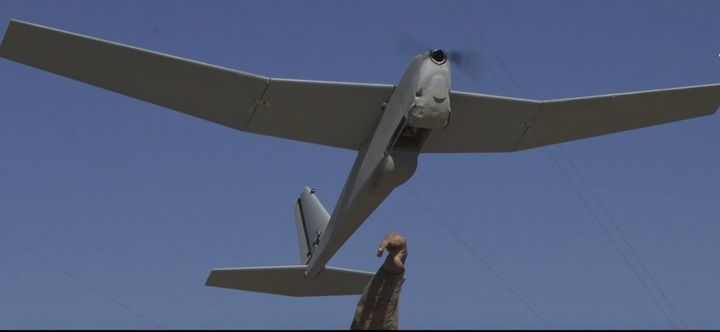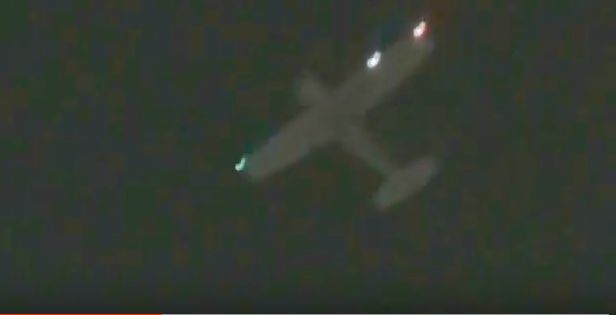Biking down 125th street last week, wiping sweat out of my eye with my shoulder, I looked up. The fucking drone I'd just seen flying over Marcus Garvey Park took off east and then north towards the South Bronx. What I first thought might've been a small plane, instead appeared like a drone with about an 8-10 foot wingspan. There was no cockpit and it was flying in between buildings and hovering at times. Assuming that most civilians couldn't easily get their hands on a large, winged drone, it's also safe to imagine that not just anyone would be allowed to fly one over Manhattan without police knowing it.
My best sense, therefore, is that it in all likelihood it was an NYPD drone. No other city agency has the resources and ambition to get in on the drone act and none, other than the police department, has shown a willingness to use them. Shockingly, the police department didn't return my emails for comment but one local reporter who asked the NYPD about drones says the department has denied owning any.
Two years ago, at his first city council hearing since returning to head the NYPD, commissioner Bill Bratton testified that the department was seriously considering using drones. In 2013, the former NYPD commissioner, Ray Kelly, made similar comments about the department's interest in using drones to monitor large protests. In December of 2014 city councilmembers Dan Garodnick and Paul Vallone introduced legislation to ban drones in the city--with the exception of the police. Last November the city council held hearings to discuss Garodnick's legislation, which in some sense may be little more than symbolic (the FAA makes the rules for the skies over the city, not the city council). The legislation explicitly makes an exception for NYPD use of drones, albeit with some regulations: only with warrants, flight logs, etc.
With police never ones to wait for or be reigned in by city legislators, it seems the question over NYPD drones is not if, but when.
Jose LaSalle and Steve Cruz of Copwatch Patrol Unit first saw the flying object in Spanish Harlem late Wednesday night. The way it moved "was like nothing I've ever seen," LaSalle said. CPU has their own small drone (something you can get online for a few hundred bucks) but the one in the sky that night didn't compare. It weaved in between buildings, making sharp turns and at times hovering a couple of hundred of feet up in the air. Jose called me so I took off on bike to meet them. I saw it on 122nd street and heard the soft humming of an engine as it hovered overhead for a short while. I followed it until it flew over the water and into the Bronx. It came back to Harlem at least two more times, going back and forth. It was in the sky for at least two hours until it finally took off over the East River and into Queens. Below is footage filmed by CPU:
While small private drones have already been flying over the city, including one that was misreported to have crashed into an NYPD helicopter (the helicopter chased the drone), use of drones by the nation's largest police force is huge deal. Not because the NYPD shouldn't be expected to trip over themselves to make use of more high-tech gadgetry to mirror the military's arsenal, but because if we're in the police drone era then we got here with no input from the public--not even an announcement. Then again, drones and the surveillance age more broadly were never democratically driven or transparent endeavors. In fact, information on domestic drone use is spotty at best.
A Predator drone was used in 2011 by a SWAT team in North Dakota to arrest a man who refused to return cows that had wandered onto his farm. After a standoff with police, the SWAT team brought in the Predator drone (the model used by the US military to rain hellfire missiles on Afghanistan, Iraq and other countries), which was loaned to them by the Department of Homeland Security. It was perhaps the first time known case of domestic law enforcement using a drone in US soil. During a US Senate oversight hearing in 2013, then FBI director Robert Mueller revealed that the FBI owned and used drones. In fact, you can check out a map of state and low law enforcement that use drones here. The map was created out of information obtained by the Electronic Frontier Foundation but it's only current as of 2013.
In New York, the police have set up gunshot detection systems across the city. There has been some suggestions that the systems may also pick up and record street conversations. And there is of course Bratton's continuous reminders that the NYPD has begun the age of 'predictive policing', which seeks to map out crime and predict future transgressions. But the true measure of the police department's thirst for more spying powers and military might may be its recent gang raids, which have recently been in collaboration with federal authorities who've made use of infrared video imaging and even an armored tank that showed up the middle of a housing development in the Bronx this year.
The good news is that at least one police department abandoned its drone program after public pressure. In 2013, after protests, the mayor of Seattle promised to scrap the city's plans to use drones. A year later Seattle still hadn't returned the drones to the manufacturer's, as it had promised. Eventually the drones ended up as a 'gift' to the LAPD.
And there's also the non-drone 'civilian aircraft' surveillance of the population. In 2012, the streets of Compton were surveilled by an aircraft (presumably piloted, therefore not a 'drone') outfitted with all sorts of monitoring equipement for the benefit of the Los Angeles County Sherriff's Department. An Ohio-based company started by a guy who reportedly cut his teeth providing surveillance technology for the US military, provided the police with test runs of the company's monitoring services--an experiment very much kept from the public.
Sgt. Douglas Iketani acknowledges that his agency hid the experiment to avoid public opposition. "This system was kind of kept confidential from everybody in the public,"he said. "A lot of people do have a problem with the eye in the sky, the Big Brother, so to mitigate those kinds of complaints we basically kept it pretty hush hush."


